Inherited a box of old coins and curious about the value of a 1968 Washington quarter? Perhaps you’re a seasoned collector looking to expand your collection.
This guide dives deep into the worth of 1968 Washington quarters, helping you determine if it’s a profitable addition to your collection or a potential source of income.
Washington quarters, featuring the stoic profile of our first president, hold a special place in American coin history. While circulated examples are common and hold face value, their historical significance makes them attractive collectibles.
But the real intrigue lies in the potential for exceptional value. Here’s the exciting part: certain 1968 Washington quarters, particularly those with errors or minted in special circumstances, can fetch hundreds or even thousands of dollars!
The key lies in the coin’s condition (uncirculated specimens are more valuable) and the presence of unique errors. Knowing what to look for can transform a seemingly ordinary coin into a valuable collector’s item.
Now that you understand the potential of 1968 quarter, we’ll delve deeper into the specifics of grading, identifying errors, and ultimately, determining the value of your specific coin. So, grab your magnifying glass and get ready to embark on a journey of discovery!
| 1968 Quarter Value Chart | ||||
| Mint Mark | Good | Fine | Extremely Fine | Uncirculated |
| 1968 No-Mint Mark Quarter | $0.30 | $0.30 | $0.30 | $3,750 |
| 1968-D Quarter | $0.30 | $0.30 | $0.30 | $1,100 |
| 1968-S Proof Quarter | – | – | – | $35 |
The History Of The 1968 Quarter
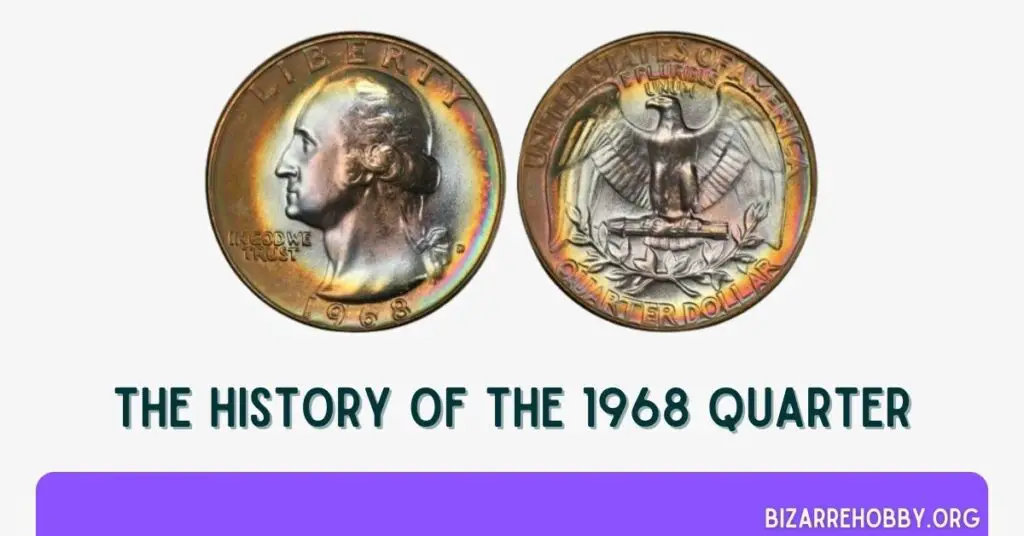
The Washington quarter, a familiar face in our pockets, boasts a rich history deeply tied to honoring America’s first president, George Washington.
In 1932, the nation geared up for the 200th anniversary of Washington’s birth. A Bicentennial Committee was formed to oversee celebrations, and a key part of the plan involved a new commemorative coin. Initially, the proposal was to replace the Walking Liberty half dollar only for 1932 with a Washington coin.
However, Congress had a different vision. They envisioned a permanent replacement for the Standing Liberty quarter, featuring a prominent portrait of Washington on the obverse (front) of the coin.
With the decision made, the Bicentennial Committee approached sculptor Lauren Fraser to design the new coin. Fraser had already been commissioned to create a commemorative presidential medal, making her a seemingly perfect choice. The Commission of Fine Arts even endorsed her work.
But fate had other plans. The final say on the designer rested with Treasury Secretary Andrew Mellon. In a surprising turn of events, Mellon rejected Fraser and opted for a new design competition. John Flanagan ultimately emerged victorious, and his design became the foundation for the Washington quarter we know today.
The Washington quarter, officially released in August 1932, was minted using 95% silver, a composition that continued until 1964. This silver content not only added value but also lent a distinctive weight and luster to the coin.
The Washington quarter’s design has remained remarkably consistent throughout its history. With the exception of the double date (1776-1976) minted in 1975 and 1976 to celebrate the Bicentennial, and a slight reduction in Washington’s bust size in 1999, the coin’s core design has endured since its 1932 debut.
So, the next time you encounter a 1968 Washington quarter, remember the rich history it embodies – a testament to our nation’s first president and a symbol that continues to circulate through generations.
Features Of The 1968 Quarter
Let’s identify your 1968 quarter! Knowing some key features will help you spot these coins and potentially discover valuable ones.
The Obverse Of The 1968 Quarter
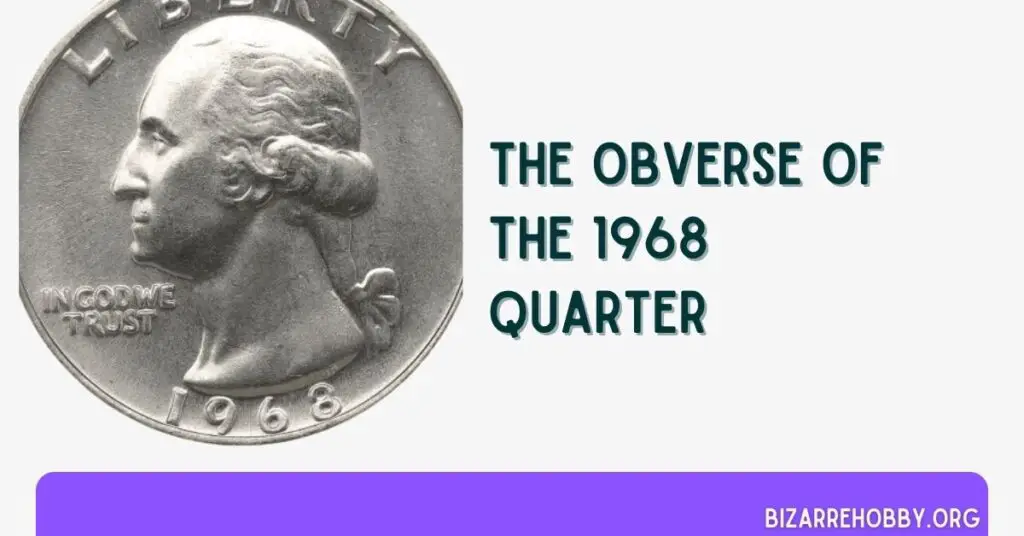
On the front, or obverse, of the 1968 coin, a portrait of George Washington dominates the design. Facing left, Washington’s hair is pulled back in a classic style. Encircling the upper rim is the inscription “LIBERTY,” while the year “1968” is located on the bottom rim. Adding the finishing touch, the national motto “IN GOD WE TRUST” is positioned on the left side.
The Reverse Of The 1968 Quarter
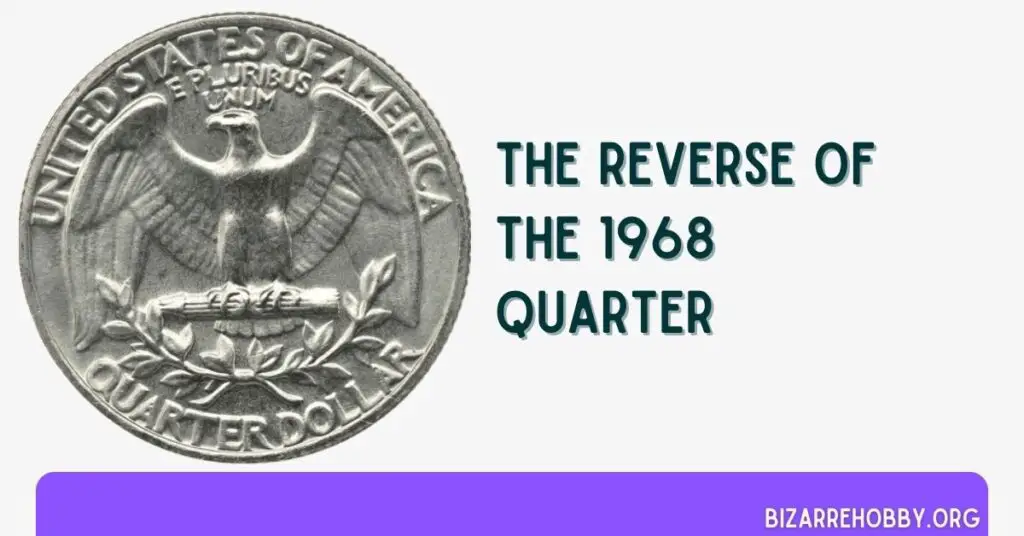
The back, or reverse, of the 1968 quarter features a more intricate design compared to the front. A powerful image of the American Bald Eagle, our national symbol, fills most of the space. The eagle’s wings are outstretched in a majestic pose, perched atop a bundle of arrows.
These arrows represent the country’s preparedness to defend its independence. In contrast to the symbol of strength, an olive branch rests directly below the eagle, signifying a desire for peace.
Curved around the upper rim is the inscription “UNITED STATES OF AMERICA,” while the national motto “E PLURIBUS UNUM” is positioned above the eagle’s head. Finally, the coin’s denomination, “QUARTER DOLLAR,” is clearly etched along the lower rim.
Other Features Of The 1968 Quarter
The 1968 quarter is constructed with a core of copper layered with a composite material. This composite cladding is comprised of 75% copper and 25% nickel. The coin itself is on the larger side, measuring 24.30 millimeters in diameter and weighing 5.67 grams.
The edge features a raised, grooved pattern called a reeded rim. Minting for the 1968 quarter occurred at three locations: Philadelphia, Denver, and San Francisco. However, only quarters minted in Denver have a distinguishing mint mark. This mark, the letter “D”, is located on the front (obverse) of the coin, near the right side of Washington’s ponytail.
1968 Quarter Grading
Washington quarters, like those from 1968, can be desirable for collectors, particularly if they’re in pristine condition. Coins that have been in circulation will likely show wear and tear, so uncirculated examples tend to hold more value.
When evaluating the condition of a 1968 quarter, the presence of a complete “mint luster” is crucial. This refers to the original shine on the coin’s surface. To check for this, hold the coin under a single light source and look for any areas where the luster seems disrupted. A coin with full mint luster is considered uncirculated.
Several key areas require close inspection. On the front (obverse), examine the top of Washington’s head, the curls near his ear, and his cheeks. An uncirculated coin should display a consistent shine across these spots, with no signs of dullness.
Similarly, on the back (reverse), pay close attention to the eagle’s breast feathers, legs, and the upper edges of its wings. In an uncirculated 1968 quarter, these areas will also have a complete and unbroken luster.
| 70-Point Scale | Grade |
|---|---|
| 1 | Basal State-1 |
| 2 | Fair |
| 3 | Very Fair |
| 4, 5, 6 | Good |
| 7, 8, 10 | Very Good |
| 12, 15 | Fine |
| 20, 30 | Very Fine |
| 40 | Extremely Fine |
| 50 | About Uncirculated |
| 60 | Mint State |
| 65 | Mint State |
| 70 | Mint State |
Please refer to our grading guides to know your exact coin scale, It’s a really necessary step in order to know the exact value of your coin.
1968 Quarter Value Guides
How much a 1968 quarter is worth depends on several factors, including its condition, mint mark, rarity, and any unique errors from the minting process.
Generally, uncirculated 1968 quarter in excellent condition (often referred to as “gem condition”) is uncommon and significantly more valuable than commonly used quarters with average or below-average wear.
Within the 1968 series, quarters minted in Philadelphia were produced in much higher quantities and typically hold less value compared to those minted in Denver or San Francisco, which had lower mintage numbers.
There are actually three distinct varieties of 1968 Washington quarters, each with its own value.
- 1968 No-Mint Mark Quarter
- 1968-D Quarter
- 1968-S Proof Quarter
1968 No-Mint Mark Quarter Value
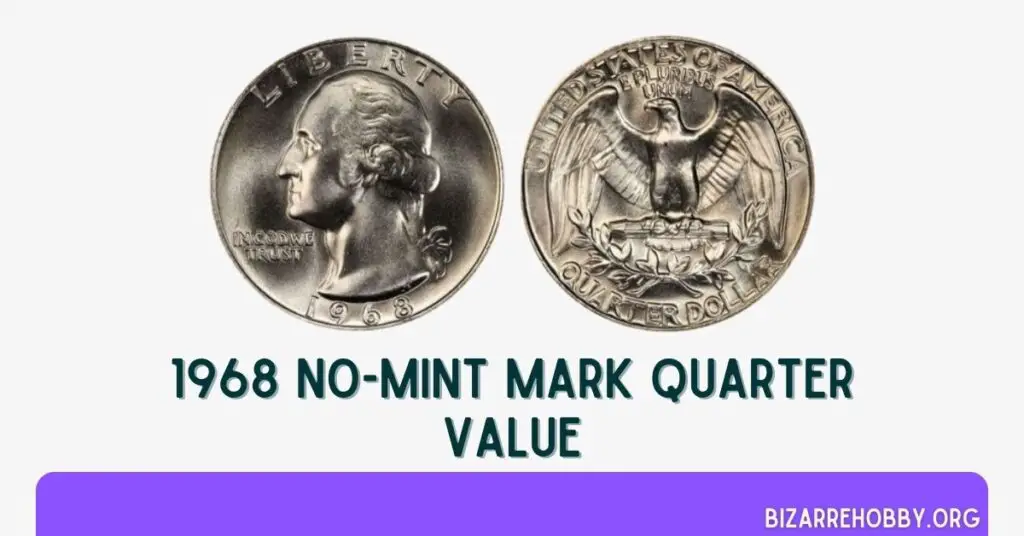
The Philadelphia mint produced the most 1968 Washington quarters, with a staggering estimated mintage of 220,731,500. Due to this high volume, these relatively old coins are readily found in circulation, though most will show signs of wear.
The high mintage also translates to a value for circulated 1968 Philadelphia quarters (those lacking a mintmark) that’s close to their face value, typically between $0.30 and $0.85. This makes them attractive options for new collectors on a budget.
Even uncirculated coins (graded “Mint State”) in lower grades, like MS62, remain affordable due to their availability, costing around $4. However, the price jumps significantly for higher mint state grades. A well-preserved example (MS66) can reach $35.
The rarest finds are gem-quality (MS67) 1968 Philadelphia quarters. These are exceptionally valuable, potentially fetching a staggering $3,750.
An exceptional case occurred in 2013 when an extremely rare 1968 Philadelphia quarter, graded MS68, sold for a whopping $9,400 at a Heritage Auctions event.
1968-D Quarter Value

The Denver mint produced a significant number of quarters in 1968, estimated at around 101,534,000. However, this is still the lowest mintage for Washington quarters since 1965. Despite this, 1968-D quarters are generally obtainable at reasonable prices across most grades. However, scarcity becomes a factor for coins graded MS65 and above.
According to the Professional Coin Grading Service (PCGS), there are only an estimated 200 surviving examples of 1968-D quarters in top condition (MS67), and even fewer (less than a dozen) graded MS68, with none known to be higher.
Similar to Philadelphia-minted quarters, circulated 1968-D coins hold a value close to their face value, ranging from $0.30 to $0.85. Uncirculated examples (graded “Mint State”) remain affordable up to a certain point. You can find an MS65 for around $10 and an MS67 for roughly $50.
As with the Philadelphia mint, gem-quality (MS68) 1968-D quarters are exceptionally rare and command premium prices. Existing examples can fetch up to $1,100.
The record holder for the most expensive 1968-D quarter is a specimen graded MS68 that sold for a staggering $8,813 at a 2013 Heritage Auction. This exemplifies the exceptional value these rare coins can hold.
1968-S Proof Quarter

Unlike the Philadelphia and Denver mints, the San Francisco facility only produced special “proof” coins intended for collectors in 1968. The estimated mintage for these 1968-S proof quarters is around 3,041,506.
Proof coins are created using specialized dies, resulting in exceptional characteristics like a high-luster finish, sharp details, and a frosted surface. Available in “Cameo” and “Deep Cameo” finishes, 1968-S proof quarters can be a valuable addition to your collection.
It’s important to note that these coins become exceptionally rare for grades of PF68 (Cameo) and PF69 (Deep Cameo) within the 1960s Washington proof series, with estimates suggesting less than 100 and 50 surviving specimens, respectively.
Despite their rarity potential, 1968-S proof quarters are surprisingly accessible to new collectors, with prices ranging from $10 to $35 for standard grades.
As with other mintmarks, Cameo and Deep Cameo finishes significantly impact value. The most expensive 1968-S proof quarter to date, graded PF69 (Deep Cameo), fetched a remarkable $2,875 at a 2007 Heritage Auction sale.
Rare 1968 Quarter Errors List
While 1968 Washington quarters were generally produced well, occasional errors can occur during the minting process. The good news is that certain errors can significantly enhance the value of your coin. So, if you have a 1968 quarter with an unusual appearance, it’s worth investigating its potential value as a collectible error coin.
Below, we’ll explore some of the common errors found on 1968 Washington quarters to keep an eye out for.
1968 Filled-In Mint Mark Quarter Error
For collectors, mint marks themselves add interest to a coin. So, it’s no surprise that anomalies related to the mint mark can generate excitement.
A prime example is the 1968 “filled-in mint mark” error on Denver-minted quarters (marked with a “D”). In this error, the small space within the “D” is filled with metal, making it appear like a raised dot.
This particular error can be quite desirable to collectors, with some examples fetching as much as $100 for 1968 Washington quarters.
1968 Quarter Struck On A Silver Planchet Error
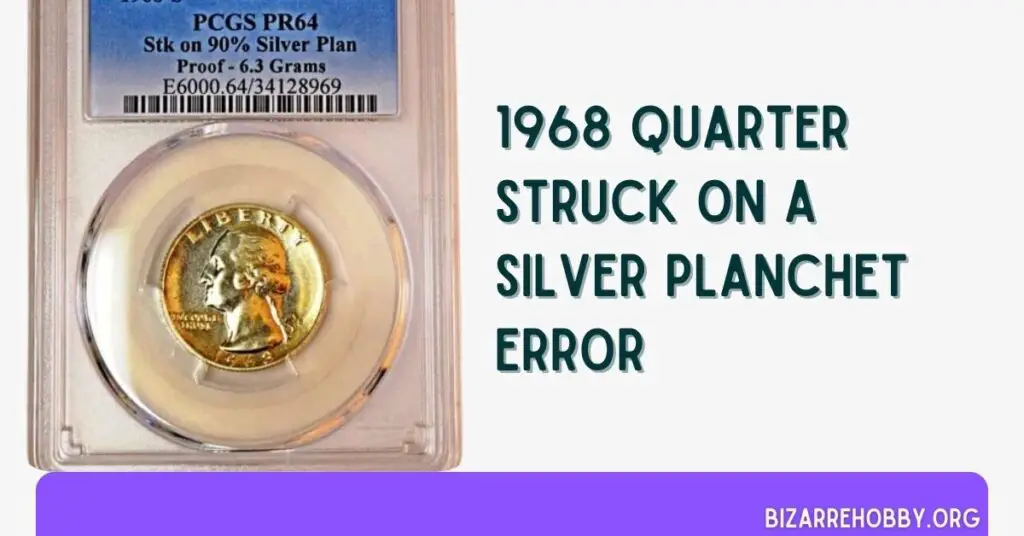
The 1968 Washington quarter series boasts one of its most unique and coveted errors: the “silver planchet” error. In 1965, the U.S. Mint transitioned from using silver to a copper-nickel alloy for quarters. However, in rare instances, a leftover silver planchet (a blank coin disc) from before 1965 might have mistakenly entered the minting process. This planchet would then be struck with the 1968 dies, creating an extraordinary error coin.
The exact cause of this error remains unclear, but the possibility exists that a stray silver planchet somehow made its way through the minting stages and ended up being struck with the 1968 dies.
Due to its rarity, with only a handful of confirmed examples, the 1968 silver planchet error is a highly sought-after prize for collectors. Unsurprisingly, these exceptional error coins can command prices in the thousands of dollars.
1968 Off-Center Quarter Error
Off-center errors occur during the minting process when the planchet (blank coin disc) isn’t perfectly positioned. This misalignment results in the design elements being struck off-center, potentially cutting off some details on the coin.
The value of an off-center error hinges on the severity of the misalignment, with coins exhibiting a greater off-center percentage (meaning a larger portion of the design is off-center) typically holding more value. In general, off-center strikes exceeding 50% are considered more valuable.
For 1968 Washington quarters, off-center errors appear to be more prevalent among coins minted in Philadelphia. These errors often show the obverse design elements (including Washington’s portrait, date, and inscriptions) displaced by roughly 50% off-center.
If you discover a 1968 quarter with a significant off-center strike (around 50% or more), it could fetch you a premium of up to $150. However, it’s important to note that the actual value can vary depending on the coin’s overall condition and the specific details of the off-center error.
1968 Doubled Die Error

Another sought-after error for 1968 Washington quarters is the “doubled die” error. This occurs due to a misaligned die striking the planchet (blank coin disc) multiple times during the minting process. The consequence is a doubling effect on the design elements that are transferred to the coin.
For the 1968 doubled die error, you’ll typically see this doubling on the obverse (front) of the coin, affecting elements like the inscription “IN GOD WE TRUST” and the date. The reverse (back) of the coin may also exhibit doubling, particularly on the inscriptions and along the edges of the eagle’s wings.
The value of a 1968 doubled die error can range from $20 to $190. However, the specific value depends on the overall condition of the coin and the severity of the doubling effect. Coins with more pronounced doubling will typically command higher prices.
Where To Sell Your 1968 Quarter ?
Now that you know the worth of your coins, do you know where you can sell them quickly online? Don’t worry, I’ve produced a list of these websites, complete with introductions, pros, and disadvantages.
Check out: Best Places To Sell Coins Online (Pros & Cons)
FAQs on 1986 Quarter Values
Do All 1968 Quarters Have Mint Marks?
While all three U.S. mints (Philadelphia, Denver, and San Francisco) produced quarters in 1968, only those minted in Denver carry a distinct mint mark. This mark, a letter “D,” is located on the front (obverse) of the coin, near Washington’s ponytail.
What Is Special About The 1968 Quarter?
1968 Washington quarters are common and affordable, even in uncirculated condition. However, the S-on-D error variety makes them interesting for collectors. We’ll explore this error next!
Is The 1968 Quarter Made Of Silver?
1968 quarters are NOT silver! The U.S. Mint switched to copper-nickel clad quarters in 1965.
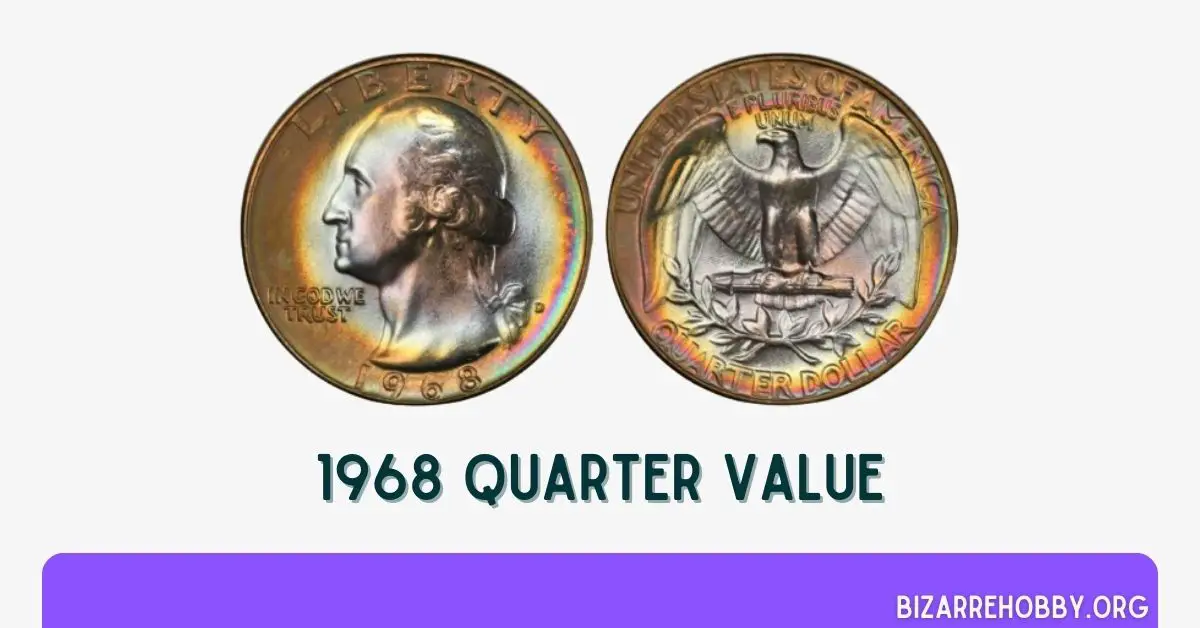
Thank You! Great info and explanations.
You are Welcome, Artduran!